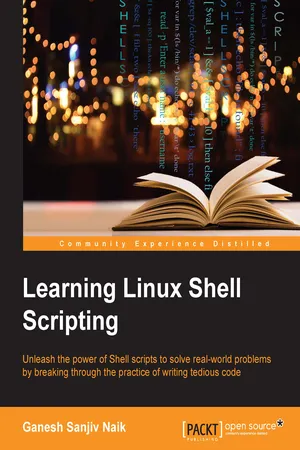
- 306 pages
- English
- ePUB (mobile friendly)
- Available on iOS & Android
Learning Linux Shell Scripting
About This Book
Unleash the power of shell scripts to solve real-world problems by breaking through the practice of writing tedious code
About This Book
- Learn how to efficiently and effectively build shell scripts and develop advanced applications with this handy book
- Develop high quality and efficient solutions by writing professional and real-world scripts, and debug scripts by checking and shell tracing
- A step-by-step tutorial to automate routine tasks by developing scripts from a basic level to very advanced functionality
Who This Book Is For
This book is ideal for those who are proficient at working with Linux and who want to learn about shell scripting to improve their efficiency and practical skills. By the end of this book, you will be able to confidently use your own shell scripts in the real world.
What You Will Learn
- Familiarize yourself with the various text filtering tools available in Linux
- Combine the fundamental text and file processing commands to process data and automate repetitive tasks
- Understand expressions and variables and how to use them practically
- Automate decision-making and save a lot of time and effort of revisiting code
- Get to grips with advanced functionality such as using traps and signals and using dialogs to develop screens
- Start up a system and customize a Linux system
- Take an in-depth look at regular expressions and pattern matching to understand the capabilities of scripting
In Detail
Linux is the one of the most powerful and universally adopted OSes. Shell is a program that gives the user direct interaction with the operating system. Scripts are collections of commands that are stored in a file. The shell can read this file and act on the commands as if they were typed on the keyboard. Shell scripting is used to automate day-to-day administration, and for testing or product development tasks.
This book covers Bash, GNU Bourne Again SHell, preparing you to work in the exciting world of Linux shell scripting. We start with an introduction to the Shell environment and explain basic commands used in Shell. Next we move on to check, kill, and control the execution of processes in Linux OS. Further, we teach you about the filter tools available in Linux and explain standard output and standard errors devices.
Then we will ensure you understand Shell's interpretation of commands and get a firmer grasp so you use them in practice. Next, you'll experience some real-world essentials such as debugging and perform Shell arithmetic fluently. Then you'll take a step ahead and learn new and advanced topics in Shell scripting, such as starting up a system and customizing a Linux system. Finally, you'll get to understand the capabilities of scripting and learn about Grep, Stream Editor, and Awk.
Style and approach
This practical book will go from the very basics of shell scripting to complex, customized automation. The idea behind this book is to be as practical as possible and give you the look and feel of what real-world scripting is like.
Frequently asked questions
Information
Learning Linux Shell Scripting
Table of Contents
Table of contents
- Learning Linux Shell Scripting